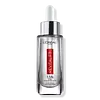What's inside
What's inside
 Key Ingredients
Key Ingredients

 Benefits
Benefits

 Concerns
Concerns

No concerns
 Ingredients Side-by-side
Ingredients Side-by-side

Water
Skin ConditioningButylene Glycol
HumectantGlycerin
HumectantGlycereth-26
HumectantAlcohol
AntimicrobialCyclopentasiloxane
EmollientCyclohexasiloxane
EmollientNiacinamide
Smoothing1,2-Hexanediol
Skin ConditioningHydroxyethyl Acrylate/Sodium Acryloyldimethyl Taurate Copolymer
Emulsion StabilisingBis-PEG-18 Methyl Ether Dimethyl Silane
EmollientAvena Sativa Kernel Extract
AbrasivePEG-60 Hydrogenated Castor Oil
EmulsifyingXanthan Gum
EmulsifyingPvp
Emulsion StabilisingPropanediol
SolventDimethiconol
EmollientAcrylates/C10-30 Alkyl Acrylate Crosspolymer
Emulsion StabilisingTromethamine
BufferingSodium Polyacrylate
AbsorbentParfum
MaskingMethoxy PEG-114/Polyepsilon Caprolactone
BufferingDisodium EDTA
Adenosine
Skin ConditioningPhenoxyethanol
PreservativeSorbitan Isostearate
EmulsifyingPolysorbate 60
EmulsifyingCitrus Junos Fruit Extract
Skin ConditioningHoney
HumectantLilium Candidum Bulb Extract
Skin ConditioningPaeonia Albiflora Root Extract
Skin ConditioningNelumbo Nucifera Flower Extract
Skin ConditioningPolygonatum Officinale Rhizome/Root Extract
Skin ConditioningRehmannia Glutinosa Root Extract
Skin ConditioningEthylhexylglycerin
Skin ConditioningGlycyrrhiza Uralensis Root Extract
Skin ConditioningPinus Koraiensis Seed Extract
PerfumingSesamum Indicum Seed Extract
Skin ConditioningPrunus Mume Fruit Extract
HumectantRosa Multiflora Fruit Extract
MaskingChaenomeles Sinensis Fruit Extract
AntioxidantTheobroma Cacao Extract
Skin ConditioningDextrin
AbsorbentBeta-Glucan
Skin ConditioningPoncirus Trifoliata Fruit Extract
Skin ConditioningPrunus Mume Flower Extract
Skin ConditioningPotassium Hydroxide
BufferingAcetic Acid
BufferingBHT
AntioxidantWater, Butylene Glycol, Glycerin, Glycereth-26, Alcohol, Cyclopentasiloxane, Cyclohexasiloxane, Niacinamide, 1,2-Hexanediol, Hydroxyethyl Acrylate/Sodium Acryloyldimethyl Taurate Copolymer, Bis-PEG-18 Methyl Ether Dimethyl Silane, Avena Sativa Kernel Extract, PEG-60 Hydrogenated Castor Oil, Xanthan Gum, Pvp, Propanediol, Dimethiconol, Acrylates/C10-30 Alkyl Acrylate Crosspolymer, Tromethamine, Sodium Polyacrylate, Parfum, Methoxy PEG-114/Polyepsilon Caprolactone, Disodium EDTA, Adenosine, Phenoxyethanol, Sorbitan Isostearate, Polysorbate 60, Citrus Junos Fruit Extract, Honey, Lilium Candidum Bulb Extract, Paeonia Albiflora Root Extract, Nelumbo Nucifera Flower Extract, Polygonatum Officinale Rhizome/Root Extract, Rehmannia Glutinosa Root Extract, Ethylhexylglycerin, Glycyrrhiza Uralensis Root Extract, Pinus Koraiensis Seed Extract, Sesamum Indicum Seed Extract, Prunus Mume Fruit Extract, Rosa Multiflora Fruit Extract, Chaenomeles Sinensis Fruit Extract, Theobroma Cacao Extract, Dextrin, Beta-Glucan, Poncirus Trifoliata Fruit Extract, Prunus Mume Flower Extract, Potassium Hydroxide, Acetic Acid, BHT
 Reviews
Reviews

Ingredients Explained
These ingredients are found in both products.
Ingredients higher up in an ingredient list are typically present in a larger amount.
Disodium EDTA plays a role in making products more stable by aiding other preservatives.
It is a chelating agent, meaning it neutralizes metal ions that may be found in a product.
Disodium EDTA is a salt of edetic acid and is found to be safe in cosmetic ingredients.
Learn more about Disodium EDTAGlycerin is already naturally found in your skin. It helps moisturize and protect your skin.
A study from 2016 found glycerin to be more effective as a humectant than AHAs and hyaluronic acid.
As a humectant, it helps the skin stay hydrated by pulling moisture to your skin. The low molecular weight of glycerin allows it to pull moisture into the deeper layers of your skin.
Hydrated skin improves your skin barrier; Your skin barrier helps protect against irritants and bacteria.
Glycerin has also been found to have antimicrobial and antiviral properties. Due to these properties, glycerin is often used in wound and burn treatments.
In cosmetics, glycerin is usually derived from plants such as soybean or palm. However, it can also be sourced from animals, such as tallow or animal fat.
This ingredient is organic, colorless, odorless, and non-toxic.
Glycerin is the name for this ingredient in American English. British English uses Glycerol/Glycerine.
Learn more about GlycerinPhenoxyethanol is a preservative that has germicide, antimicrobial, and aromatic properties. Studies show that phenoxyethanol can prevent microbial growth. By itself, it has a scent that is similar to that of a rose.
It's often used in formulations along with Caprylyl Glycol to preserve the shelf life of products.
Water. It's the most common cosmetic ingredient of all. You'll usually see it at the top of ingredient lists, meaning that it makes up the largest part of the product.
So why is it so popular? Water most often acts as a solvent - this means that it helps dissolve other ingredients into the formulation.
You'll also recognize water as that liquid we all need to stay alive. If you see this, drink a glass of water. Stay hydrated!
Learn more about Water